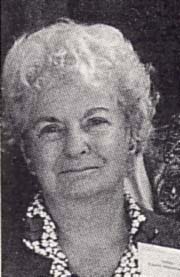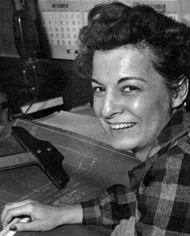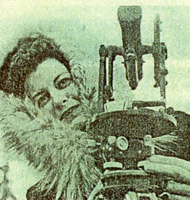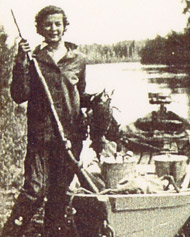1954-1963 Helen Atkinson
1954-1963 Helen Atkinson
Fairbanks

Helen Atkinson, the University of Alaska's first woman graduate with a degree in civil engineering, is not the stereotype of the female battling for recognition in what is generally thought of as a man's world. Her indomitable and determined spirit has not destroyed an innate femininity; her natural beauty is enhanced by a vivacious personality. Her varied successes in life have not robbed her of an innate shyness and humility.
Born 1915 in Goldroad, Ariz. she moved to Eureka, Colo., at age 11 and a year later to Pasadena, Calif., and the following year to Fairbanks, Alaska, when her father, an accountant for gold-mining companies, transferred.
Her early life was spent in mining camps —she learned to take life as it came. Such training was destined to stand her well in future years when she was obliged to make her own way, supporting four little ones without a husband's assistance.
After graduating from the Fairbanks high school and the University of Alaska, she went to work with the Fairbanks Exploration company as a drafting engineer. Afterwards, she took a year to study architecture at the University of Washington in Seattle. After returning to Fairbanks in 1937, she married Frank White. She worked at Cann Studio until 1939, when her first child was born. Three daughters were born of this marriage—Phyllis, Gayle and Avriel.

When the United States became involved in World War II, Helen got a job with the Boeing plane company in Seattle, first writing shop orders for airplane parts, then as a flight inspector of B-29 bombers, attending vocational school to study aircraft engines, and learned to fly in her spare time. She worked on B-29 bombers and the first strata-cruiser. She soloed in 1943 and was accepted into the WASPS. She requested a deferment when she realized she could not get her two small daughters properly taken care of while she would be ferrying planes to Europe. Gen. Hap Arnold's office granted deferment, as her job at Boeing was considered as vital to the war effort.
When the war was over, Helen headed north again with her family, this time stopping in southeastern Alaska for six years, where Frank got a job as a Civil Aeronautics Administration (CAA) radio technician. It was while living there that her third daughter was born. They transferred to Lake Minchumina, where Helen worked for the CAA as a surveyor before returning to Fairbanks.

When Helen and her daughters returned to Fairbanks in 1951, Frank stayed in Minchumina.
The two later divorced. Back in Fairbanks, Helen worked as assistant engineer for
the city of Fairbanks until she was promoted to city engineer when the former engineer
became city manager. On New Year's Eve, 1952 she married Don Eyinck, whom she had
succeeded as city engineer when he was appointed city manager. The marriage ended
in divorce a few years later, in 1956.
Governor Frank Heintzleman appointed her to the Board of Regents of the University
of Alaska in early 1954, during an interim period for the legislature, which met every
two years before statehood. She served all of 1954 before the Legislature met in 1955
to confirm her for another eight years. Helen served nine years on the Board of Regents.
She also served as president of the UAF Heating Corporation Board for 15 years; on
the executive committee of the UAF Technological Development Corp; and she is a current
member of several other UAF boards and committees.

A new field of interest had opened up to Helen Atkinson while employed with the Yukan Oil and Gas company in the late 1950s, making maps and filing leases for oil companies. She and Ben Atkinson started the "Alaska Oil Report," a weekly that Helen wrote, printed, and mailed to 200 subscribers. When Yukon Oil and Gas folded, she continued to publish.
She became famous as an expert on oil exploration in the Arctic. As a free-lance writer, she became a stringer for several publications outside Alaska, including Oil Week, Calgary, Canada and California Oil World. Her articles on Prudhoe Bay oil exploration were reprinted far and wide, including the Congressional Record. Her reports were based on first-hand knowledge. She made many trips to the North Slope. She flew in helicopters and planes, traveled with tugs and barges, and accompanied the first convoy of heavy equipment over the "Ice-Hickel" highway from Fairbanks through Dietrich Pass in the Brooks Range—before the highway was built.

British-Petroleum borrowed her from her Fairbanks office to spend two weeks in the states to tell about Alaskan oil explorations. In a seven-day interval during that trip, Helen made five TV appearances, four radio shows and gave six newspaper interviews.
Helen married Ben Atkinson on Valentine's Day in 1959; sadly, he died in 1966 of a sudden heart attack when their son was only six years old. They had lived on campus, but Helen was asked to leave after Ben's death. It wasn't easy to find a new place to live after seven years with Ben. That winter, she house sat for some snowbirds. In summer, she trailer sat for friends until she started to build a house on some land she'd been paying on.
In 1967, Helen worked first as coordinator of creative arts for A-67; then as project manager for Alaska State Housing Authority for four years—finding new homes for people displaced by urban renewal. Next, she spent another four years working for GVEA as right-of-way engineer.

When the pipeline boom arrived, she took a job with the Fairbanks Daily News-Miner as a correspondent, and later became resources editor and made many trips to the North Slope. In 1971, she received the Alaska Press Women's Gold Nugget Award. In 1978, she completed a 15-chapter book for Green Construction on their Alaskan projects. Helen travelled to Russia, Japan, and China to write about construction projects.
In 1982, she started painting watercolors; she has exhibited and sold paintings in Alaska and California. She traveled with artists to paint in Guatemala, Mexico, Portugal, France, Greece, Scotland, Italy, England, and China. Memories and pictures of other trips to East Africa, Australia, New Zealand, Thailand, Singapore, and Turkey are treasured. Someday she hopes to write stories or paint scenes of those travels. In May 2005, on her 90th birthday, she had a solo watercolor show of 37 paintings at the New Horizon Gallery in Fairbanks.

In the 1990s, she wrote a story for a bronze plaque in Golden Heart Plaza; she also designed a stained glass window for St. Matthew's Episcopal Church.
In 2003, she was selected by the university to receive an Honorary Doctorate of Laws degree for her long-time commitment and contributions to the university and Fairbanks community. She was also inducted into the Chi Epsilon National Civil Engineering Society.
Helen married Conrad Frank in 1975, also a previous regent. They live in Fairbanks and have an extended family between them of eight children and a present total of 31 grandchildren and great-grandchildren.

Information from:
Board of Regents history file
Helen Atkinson biography written by Phyllis Tate Helen Atkinson Other Links:
Friends of the University Board Members
UAF Sites Named After
